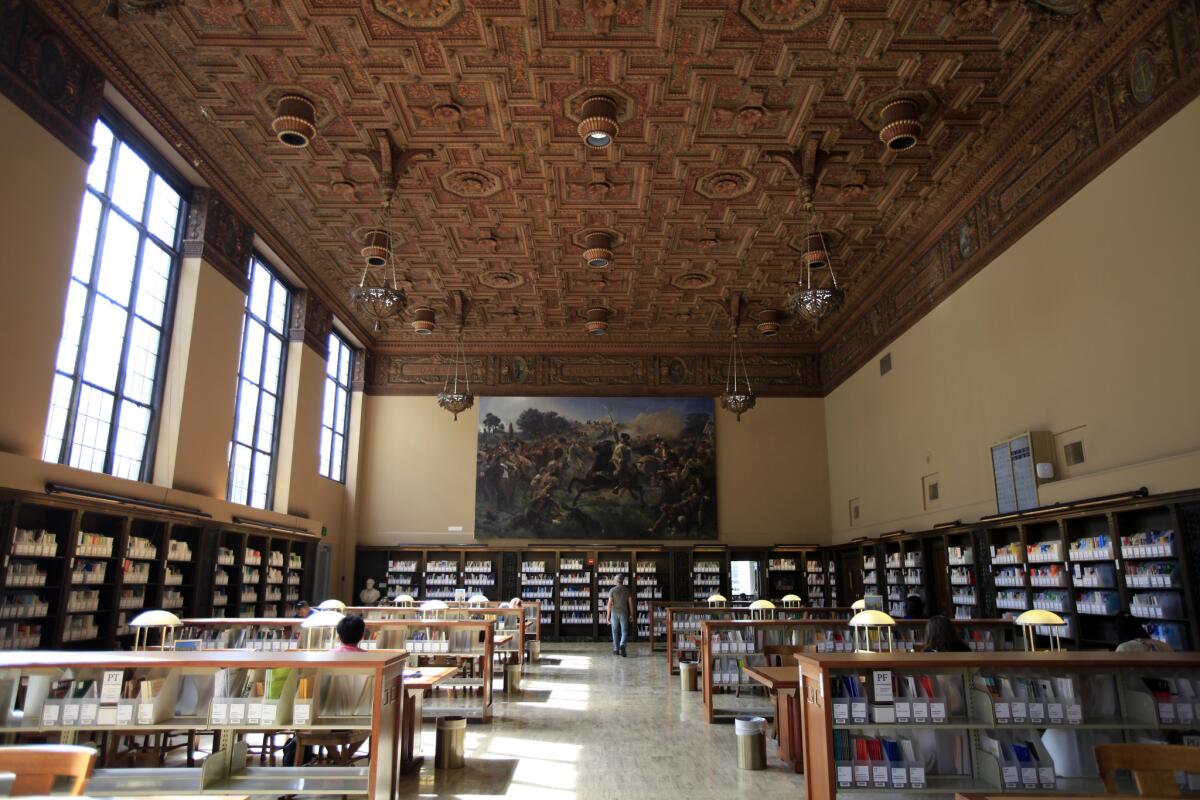Fewer Californians got into UC, while offers to foreign students rose

The Roger W. Heyns Reading Room at UC Berkeley. Applicants to the campus faced tough odds.
- Share via
With the number of UC applicants at a new high, California residents faced tougher odds of gaining acceptance into next fall’s freshman classes. A record number of students from other countries and states, meanwhile, received offers of admission.
About 60% of the 103,117 California applicants were offered a spot on at least one of UC’s nine undergraduate campuses, according to university figures released Thursday. That appears to be a record low acceptance rate, down from about 63% of the 99,955 applicants last year, and about 79% in 1999, the oldest available systemwide figures.
However, Stephen Handel, UC associate vice president for undergraduate admissions, said that interest is so strong in the public university system that he expects the ranks of California freshmen will remain about the same as in this past school year, even though the 61,834 Californians accepted to UC were about 1,000 fewer than last year. Their ethnic composition continues to shift from whites to more Asians and Latinos.
The UC system seems to be maintaining the promise of President Janet Napolitano that the numbers of students from other states and countries would not increase further at UC Berkeley and UCLA. The rapid rise in recent years in those students at the two highly selective campuses — to about 30% of the freshmen class — triggered much controversy among legislators and families.
The debate over the pursuit of those students for the extra tuition they pay may now expand to other UC schools. Irvine, San Diego and Davis offered entrance to significantly more non-Californians than in the past, although it remains unclear whether those schools have the same cachet as UCLA and Berkeley to large numbers of students from New York, China and elsewhere.
While accepting about the same numbers of Californians as last year, UC San Diego offered freshman spots to 10,313 students from other states and countries, up from 8,765 last year; Irvine accepted 9,413 of them, up from 6,564.
UC Irvine spokeswoman Cathy Lawhon said that there is room on campus for more students but state funding won’t accommodate more Californians. The higher tuition nonresidents pay more fully covers costs. “Even if we took no more out-of-state and international students, we would not be able to take more Californians,” she said.
Across all nine UC campuses, 15,173 applicants from other states were offered a freshman spot — 1,711 more than last year — but their
admission rate dropped to 49.6% from 51.3% because the number of those applicants rose so much. Among international students, 15,317, or 62.2% of those applicants, were admitted, compared with 13,575, or 60.1%, last year, the data showed. Students from China, Korea and India made up the largest foreign groups, according to UC.
Nonresident students constitute about 13% of UC’s total undergraduate student body.
Under the state budget pact, tuition for Californians will remain frozen for two more years. Out-of-staters will see a 5% cost increase; they will pay $36,900 next year compared with the $12,200 resident tuition.
Napolitano faces pressure from Gov. Jerry Brown and the Legislature to significantly increase the enrollment of both California freshman and transfer students for fall 2016. Handel said Thursday that the university is studying ways to achieve those goals.
William G. Tierney, co-director of USC’s Pullias Center for Higher Education, said those UC campuses beyond UCLA and UC Berkeley will be able to attract international students, particularly those from Asia, but probably have less success with Americans from other states.
U.S. students are knowledgeable about specific campuses and cities, while students from China, for example, may be less choosy, he said. “It’s a UC degree they want,” Tierney said.
While Napolitano kept her agreement to freeze the number of non-Californians at UCLA and Berkeley, shifting their growth elsewhere will lead to more Californians who are upset about that issue around the state, Tierney said.
Once again, UCLA was the most difficult of the UC schools for Californians. The Westwood campus accepted just 16.2% of those in-state applicants, down from 16.7% last year. Berkeley was the next toughest, with 19.1%, down from 19.7%. UC San Diego accepted 30.2% of its
California applicants; Davis, 32.8%; Irvine, 33.4%; Santa Barbara, 33.5%; Santa Cruz; 46.3%; Riverside, 56.7%; and Merced, 66.1%.
Handel emphasized that UC has kept its commitment to offer a freshman spot to the academically top 9% of students statewide or in their high schools. That does not mean these students got into their top choices or even any of the schools to which they applied. (On average, students applied to four UC campuses.)
About 12,000 eligible applicants turned down by all UC campuses to which they applied were then offered a spot at UC Merced, the newest campus and the one seeking to grow the most. Only about 10% of those students then indicated they would consider attending Merced, Handel said.
The admissions data were delayed this year due
to what officials say was the uncertainty over the state budget. After much early disagreement with Brown and some legislators, the eventual boost in funding for UC allowed some students to be admitted from waiting lists.
Among ethnic groups in California, Asian Americans once again won the largest share of UC freshman admission offers, 36.3%, up from 36% last year, and their percentages were above 40% of offers at several campuses, including UCLA, Irvine and Berkeley.
Latinos were next, constituting 29.6% of those admitted, up from 28.9% last year when, for the first time, they surpassed the share of accepted applicants who are white. Officials say that is due to the improving high school graduation rates among Latinos along with their overall rising share of the state’s population.
Whites were 25.4% of the accepted students, down from 26.7%, and African Americans remained at 4.3%.
UC accepted nearly the same number of transfer students from California community colleges as it has for the last two years, 20,921, or 70.2% of those who applied.
Follow me @larrygordonlat.
ALSO:
Teens’ attack on Chinese girl draws comparison to ‘Lord of the Flies’ from judge
Obama mocks Republicans’ 2016 field as big enough to field a ‘Hunger Games’
Bay Area news crews robbed on live TV while reporting on homicide
More to Read
Sign up for Essential California
The most important California stories and recommendations in your inbox every morning.
You may occasionally receive promotional content from the Los Angeles Times.











